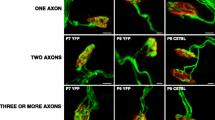Abstract
THE extent to which innervation regulates the embryonic development of skeletal muscle, and the mechanisms of nerve–muscle trophic interactions during development, are little understood. Here we describe studies on the development of skeletal muscles in rat embryos in which all the motoneurones were destroyed, and experiments in which chronic application of tetrodotoxin (TTX) to individual embryos blocked all nerve and muscle electrical activity during neuromuscular junction formation. The results are presented with special emphasis on the regulation of acetylcholine (ACh) receptor distribution. It is already known that ACh receptors in adult tissues are densely clustered under nerve terminals on both muscle1 and nerve cells2. Relatively few receptors are found in extrajunctional regions, and if these are present at all they are uniformly dispersed. Studies of individually teased muscle fibres from rat embryos have shown receptor aggregates (clusters or hotspots) to be present after 16 d gestation3, but no more is known about how these clusters are induced to form or to achieve their proper location. Studies of mouse, chick and toad muscles in tissue culture have shown that receptor clusters may form on myotubes that have developed in the absence of nerve tissue4–6. In cultured toad muscle these clusters migrate within the muscle membrane to locate beneath nerve terminals5. Here, we show that receptor clusters appear on embryonic rat muscle after 15½d gestation, with striking synchrony in timing, and an ordering of the position of clusters on different fibres within a muscle. These initial events were little changed after irreversible destruction of motoneurones at 14 d gestation except that additional receptor clusters appeared at later times. Paralysis of developing nerve and muscle with TTX did not affect the appearance and progressive increase in size of junctional clusters, but extrajunctional clusters also appeared, as in the denervated muscles. These experiments show that the first appearance of ACh receptor clusters on embryonic skeletal muscle does not depend on innervation, but that the final ordering of their position on muscle fibres and their later increase in size do require the presence, although not the electrical activity, of the nerve. Electrical activity of nerve and/or muscle is essential to suppress the appearance of extrajunctional receptor clusters, and for the normal progress of muscle growth. This study shows also that mammalian embryos are more accessible to experimental manipulation than may previously have been realised, so that toxins and metabolites may be chronically applied to embryonic tissues in vivo, as well as in tissue culture.
Similar content being viewed by others
References
Fambrough, D. M. & Hartzell, H. C. Science 176, 189–191 (1972).
Harris, A. J., Kuffler, S. W. & Dennis, M. J. Proc. R. Soc. B177, 541–553 (1971).
Bevan, S. & Steinbach, J. H. J. Physiol., Lond. 267, 195–213 (1977).
Cohen, S. A. & Fischbach, G. D. Science 181, 76–78 (1973).
Anderson, M. J., Cohen, M. W. & Zorychta, E. J. Physiol., Lond. 268, 731–756 (1977).
Christian, C. N. et al. Proc. natn. Acad. Sci. U.S.A. 75, 4011–4015.
Kelly, R. B. & Brown, F. R. J. Neurobiol. 5, 135–150 (1974).
Abe, T., Limbrick, A. R. & Miledi, R. Proc. R. Soc. B194, 545–553 (1976).
Hirokawa, N. J. comp. Neurol. 180, 449–466 (1978).
Bennett, M. R. & Pettigrew, A. G. J. Physiol., Lond. 241, 515–545 (1974).
Kelly, A. M. & Zachs, S. I. J. Cell Biol. 42, 154–169 (1969).
Harris, A. J. A. Rev. Physiol. 36, 251–305 (1974).
Steinbach, J. H., Harris, A. J., Patrick, J., Schubert, D. & Heinemann, S. J. gen. Physiol. 62, 255–270 (1973).
Pestronk, A., Drachman, D. B. & Griffin, J. W. Nature 260, 352–353 (1976).
Lavoie, P.-A., Collier, B. & Tenenhouse, A. Expl Neurol. 54, 148–171 (1977).
Albuquerque, E. X., Warnick, J. E., Tasse, J. R. & Sansone, F. M. Expl Neurol. 37, 607–634 (1972).
Cangiano, A. & Fried, J. A. J. Physiol., Lond. 265, 63–84 (1977).
Lux, H. D., Schubert, P., Kreutzberg, G. W. & Globus, A. Expl Brain Res. 10, 197–204 (1970).
Bray, J. J., Hubbard, J. I. & Mills, R. G. J. Physiol., Lond. (in the press).
Author information
Authors and Affiliations
Rights and permissions
About this article
Cite this article
BRAITHWAITE, A., HARRIS, A. Neural influence on acetylcholine receptor clusters in embryonic development of skeletal muscles. Nature 279, 549–551 (1979). https://doi.org/10.1038/279549a0
Received:
Accepted:
Published:
Issue Date:
DOI: https://doi.org/10.1038/279549a0
- Springer Nature Limited
This article is cited by
-
Molecular control of neuromuscular junction development
Journal of Cachexia, Sarcopenia and Muscle (2012)
-
Effects of tensile stress on the α1 nicotinic acetylcholine receptor expression in maxillofacial skeletal myocytes
Molecular and Cellular Biochemistry (2008)
-
Distinct roles of nerve and muscle in postsynaptic differentiation of the neuromuscular synapse
Nature (2001)
-
Embryonic somatic nerve destruction with ?-bungarotoxin
Cell and Tissue Research (1987)
-
An electrophysiological study of skeletal muscle fibres in the ‘muscular dysgenesis’ mutation of the mouse
Pflügers Archiv - European Journal of Physiology (1987)





